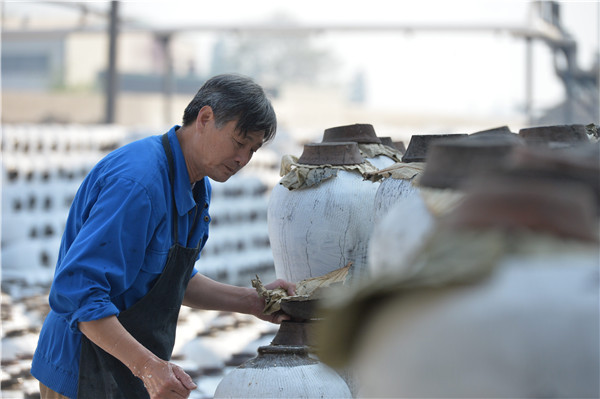Mellow yellow
 |
|
Liquor producer Xie Shouxian checks the fermentation of huangjiu in Shenyonghe Brewery in Shaoxing during its winter brewing. [Photo provided to China Daily] |
Fiery and strong baijiu, or white liquor, is a mainstay for a feast in northern China, where people "bottoms up" with the potent alcohol to show respect to each other. In southern China, however, especially along the south and lower reaches of the Yangtze River, huangjiu (yellow wine) is usually favored by people for its rich and mellow taste.
Fermented from glutinous rice and wheat, huangjiu has a hue of amber, and depending on the degree of fermentation and the aging time, the color varies from a very light gold to a deep chocolate brown. It's usually less than 20 percent alcohol by volume.
With a brewing history of more than 2,500 years, huangjiu is believed to be one of the oldest alcohol drinks in China. The earliest text record traces back to the Spring and Autumn Period (770-476 BC).
Just as Bordeaux is the holy land of wine in France, Shaoxing, an old water town an hour's drive to the southeast of Hangzhou, Zhejiang province, is widely regarded as the home for yellow wine in China. Its local brewing technique was listed as a State-level intangible cultural heritage in 2006.
Shaoxing huangjiu has been given to many foreign leaders as official state gifts. In September 2015, when President Xi Jinping visited the United States, Shaoxing huangjiu was on the menu for the state dinner in White House as a pairing wine for the wild mushroom soup with black truffle.
There are many brands and names for huangjiu, but are largely fall into four types-yuanhong (the driest, with 1 percent sugar or less), jiafan, shanniang and xiangxue (extra-sweet, with 20 percent sugar or more)-with color ranging from light to dark amber.
Yuanhong ("Champion's red" is the basic version from which the others are crafted. For example, when brewing the semi-dry jiafan, which literally translates as "add rice", the makers add more glutinous rice than the amount of rice in yuanhong, while the making of shanniang uses yuanhong to replace part of the water in its brewing process.






















